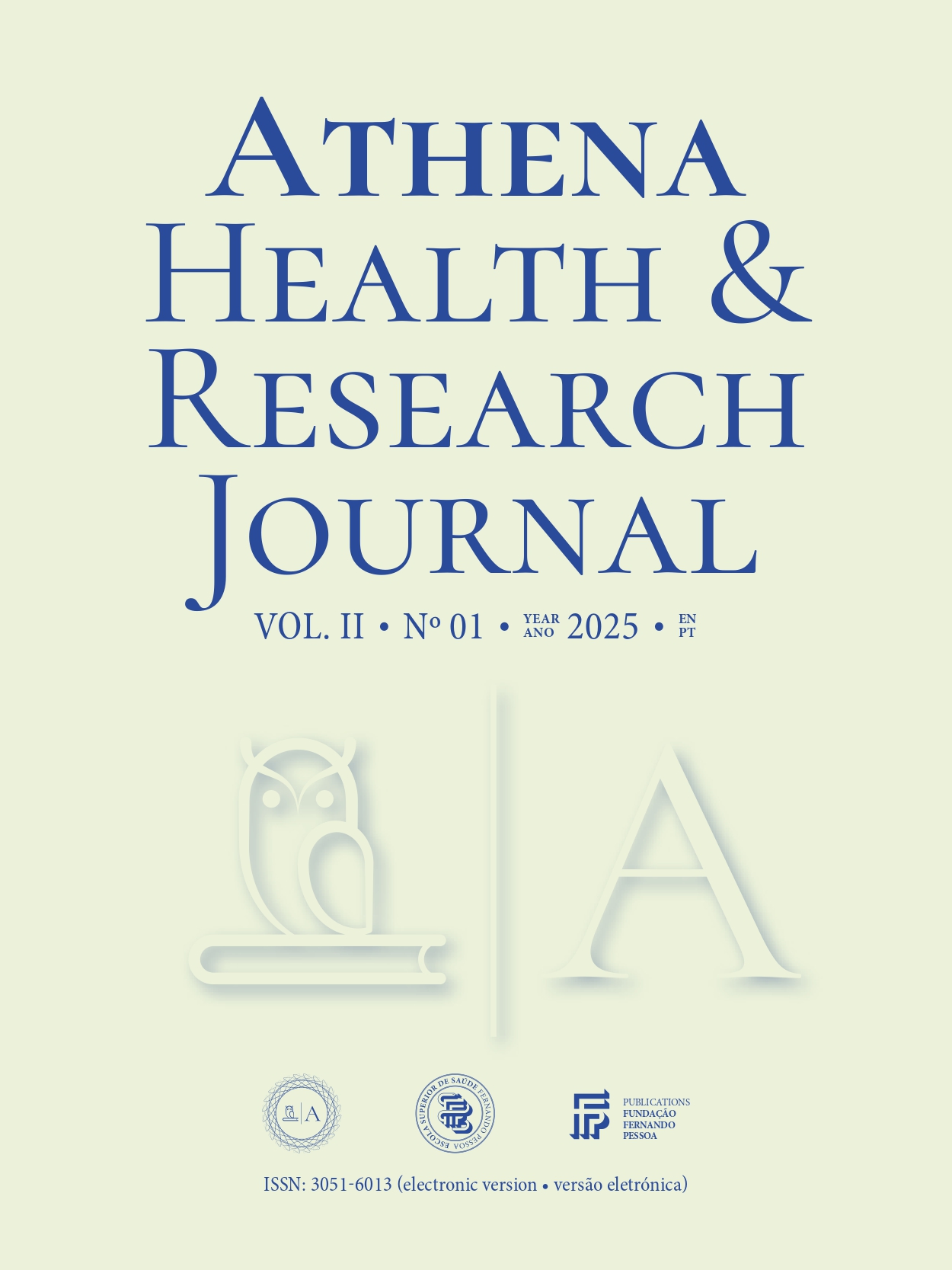Variation of knee joint-position sense of soccer players during one season: An exploratory study
Variation of knee joint-position sense of soccer players during one season
DOI:
https://doi.org/10.62741/ahrj.v2i1.32Keywords:
Joint-Position Sense, Proprioception, Soccer, Muscle Fatigue, KneeAbstract
Introduction: The distribution of injuries during a competitive season in soccer is not consensual. It is suggested that muscle fatigue may be an underlying factor of increased risk of injury when load is high during the season since an impairment in the muscle mechanoreceptors’ function has been reported, affecting the necessary proprioceptive acuity to maintain the joint stability.
Objective: To assess the variation of knee joint-position sense of soccer players during one season.
Methods: Twenty-three semi-professional soccer players (12 males and 11 females) participated in the study. Knee joint-position sense was assessed through the absolute, relative and variable angular errors of both limbs over three different moments (early-season; mid-season; and late-season). The selected target angles were 20 and 45 (for the knee extension test), and 45 and 100 (for the knee flexion test), following a non-weight bearing condition and an active repositioning method.
Results: Absolut, relative and variable angular errors of the soccer players did not change significantly over the three moments of assessment (p>0.05).
Conclusion: The knee joint-position sense of the assessed soccer players did not vary during the season and also no injuries were observed, suggesting that they were able to maintain the integrity of joint and muscle mechanoreceptors, enabling an appropriate reaction to internal and external joint disturbances.
References
Valderrabano V, Barg A, Paul J, Pagenstert G, Wiewiorski M. Foot and Ankle Injuries in Professional Soccer Players. Sport-Orthopädie - Sport-Traumatologie - Sports Orthopaedics and Traumatology. 2014/05/01/ 2014;30(2):98-105. doi:10.1016/j.orthtr.2014.04.002 DOI: https://doi.org/10.1016/j.orthtr.2014.04.002
Ekstrand J, Hägglund M, Waldén M. Epidemiology of muscle injuries in professional football (soccer). Am J Sports Med. 2011;39(6):1226-1232. doi:10.1177/0363546510395879 DOI: https://doi.org/10.1177/0363546510395879
Giza E, Mithöfer K, Farrell L, Zarins B, Gill T. Injuries in women’s professional soccer. Br J Sports Med. 2005;39(4):212-216. doi:10.1136/bjsm.2004.011973 DOI: https://doi.org/10.1136/bjsm.2004.011973
Le Gall F, Carling C, Reilly T, Vandewalle H, Church J, Rochcongar P. Incidence of injuries in elite French youth soccer players: a 10-season study. The American journal of sports medicine. 2006;34(6):928-938. doi:10.1177/0363546505283271 DOI: https://doi.org/10.1177/0363546505283271
Le Gall F, Carling C, Reilly T. Injuries in young elite female soccer players: an 8-season prospective study. The American journal of sports medicine. 2008;36(2):276-284. doi:10.1177/0363546507307866 DOI: https://doi.org/10.1177/0363546507307866
Jeong T-S, Reilly T, Morton J, Bae S-W, Drust B. Quantification of the physiological loading of one week of “pre-season” and one week of “in-season” training in professional soccer players. Journal of sports sciences. 2011;29(11):1161-1166. doi:10.1080/02640414.2011.583671 DOI: https://doi.org/10.1080/02640414.2011.583671
Hawkins RD, Hulse M, Wilkinson C, Hodson A, Gibson M. The association football medical research programme: an audit of injuries in professional football. British journal of sports medicine. 2001;35(1):43-47. DOI: https://doi.org/10.1136/bjsm.35.1.43
Pedrinelli A, da Cunha Filho GAR, Thiele ES, Kullak OP. Estudo epidemiológico das lesões no futebol profissional durante a Copa América de 2011, Argentina. Rev Bras Ortop. 2013;48(2):131-136. doi:10.1016/j.rbo.2012.09.001 DOI: https://doi.org/10.1016/j.rbo.2012.09.001
Mandorino M, Figueiredo AJ, Cima G, Tessitore A. Predictive analytic techniques to identify hidden relationships between training load, fatigue and muscle strains in young soccer players. Sports. 2022;10(1):3. doi:10.3390/sports10010003 DOI: https://doi.org/10.3390/sports10010003
Hassanlouei H, Arendt-Nielsen L, Kersting UG, Falla D. Effect of exercise-induced fatigue on postural control of the knee. Journal of Electromyography and Kinesiology. 2012;22(3):342-347. doi:10.1016/j.jelekin.2012.01.014 DOI: https://doi.org/10.1016/j.jelekin.2012.01.014
Lehnert M, De Ste Croix M, Zaatar A, Hughes J, Varekova R, Lastovicka O. Muscular and neuromuscular control following soccer‐specific exercise in male youth: Changes in injury risk mechanisms. Scandinavian Journal of Medicine & Science in Sports. 2017;27(9):975-982. doi:10.1111/sms.12705 DOI: https://doi.org/10.1111/sms.12705
Salgado E, Ribeiro F, Oliveira J. Joint-position sense is altered by football pre-participation warm-up exercise and match induced fatigue. The Knee. 2015;22(3):243-248. doi:10.1016/j.knee.2014.10.002 DOI: https://doi.org/10.1016/j.knee.2014.10.002
Carrasco L, Espinar J, Carbonell FJ, Martínez-Díaz IC. Local and general fatigue: Effects on knee proprioception in soccer players. Article. Revintmedciencactfísdeporte. 2021;21(84):683-698. doi:10.15366/rimcafd2021.84.004 DOI: https://doi.org/10.15366/rimcafd2021.84.004
Rozzi S, Yuktanandana P, Pincivero D, Lephart S. Role of fatigue on proprioception and neuromuscular control. Proprioception and neuromuscular control in joint stability IL: Human Kinetics; 2000:375-384.
Pedersen J, Ljubisavljevic M, Bergenheim M, Johansson H. Alterations in information transmission in ensembles of primary muscle spindle afferents after muscle fatigue in heteronymous muscle. Neurosci. 1998/02/24/ 1998;84(3):953-959. doi:10.1016/S0306-4522(97)00403-X DOI: https://doi.org/10.1016/S0306-4522(97)00403-X
Maqsood M, Váczi M. Immediate Effects of Quadriceps Muscle Kinesiology Taping on Joint Position Sense and Force Sense in Healthy Individuals. Preprints: Preprints; 2023. DOI: https://doi.org/10.20944/preprints202303.0188.v1
Porac C, Coren S. Lateral Preferences and Human Hehavior. Springer-Verlag; 1981. DOI: https://doi.org/10.1007/978-1-4613-8139-6
Azevedo J, Rodrigues S, Moreira-Silva I, Cardoso R, Seixas A. Acute effects of muscle fatigue on the knee joint-position sense of trained and non-trained individuals. Athena Health & Research Journal. 2024;1(1)doi:10.62741/ahrj.v1i1.8 DOI: https://doi.org/10.62741/ahrj.v1i1.8
Proske U. A reassessment of the role of joint receptors in human position sense. Exp Brain Res. 2023;241(4):943-949. doi:10.1007/s00221-023-06582-0 DOI: https://doi.org/10.1007/s00221-023-06582-0
Ribeiro F, Mota J, Oliveira J. Effect of exercise-induced fatigue on position sense of the knee in the elderly. European journal of applied physiology. 2007;99(4):379-385. doi:10.1007/s00421-006-0357-8 DOI: https://doi.org/10.1007/s00421-006-0357-8
Clark NC, Akins JS, Heebner NR, et al. Reliability and measurement precision of concentric-to-isometric and eccentric-to-isometric knee active joint position sense tests in uninjured physically active adults. Physical Therapy in Sport. 2016;18:38-45. doi:10.1016/j.ptsp.2015.06.005 DOI: https://doi.org/10.1016/j.ptsp.2015.06.005
Olsson L, Lund H, Henriksen M, Rogind H, Bliddal H, Danneskiold-Samsøe B. Test–retest reliability of a knee joint position sense measurement method in sitting and prone position. Adv Physiother. 2004;6(1):37-47. doi:10.1080/14038190310009894 DOI: https://doi.org/10.1080/14038190310009894
Cloete T, Scheffer C. Repeatability of an off-the-shelf, full body inertial motion capture system during clinical gait analysis. Engineering in Medicine and Biology Society (EMBS), 2010 Annual International Conference of the IEEE. 2010:5125-5128. doi:10.1109/IEMBS.2010.5626196. DOI: https://doi.org/10.1109/IEMBS.2010.5626196
Bennell K, Wee E, Crossley K, Stillman B, Hodges P. Effects of experimentally‐induced anterior knee pain on knee joint position sense in healthy individuals. J Orthop Res. 2005;23(1):46-53. doi:10.1016/j.orthres.2004.06.008 DOI: https://doi.org/10.1016/j.orthres.2004.06.008
Impellizzeri FM, Menaspà P, Coutts AJ, Kalkhoven J, Menaspa MJ. Training load and its role in injury prevention, part I: back to the future. Journal of athletic training. 2020;55(9):885-892. doi:10.4085/1062-6050-500-19 DOI: https://doi.org/10.4085/1062-6050-500-19
Alentorn-Geli E, Myer GD, Silvers HJ, et al. Prevention of non-contact anterior cruciate ligament injuries in soccer players. Part 1: Mechanisms of injury and underlying risk factors. Knee Surgery, Sports Traumatology, Arthroscopy. 2009/07/01 2009;17(7):705-729. doi:10.1007/s00167-009-0813-1 DOI: https://doi.org/10.1007/s00167-009-0813-1
Read PJ, Oliver JL, De Ste Croix MBA, Myer GD, Lloyd RS. Neuromuscular Risk Factors for Knee and Ankle Ligament Injuries in Male Youth Soccer Players. Sports Medicine. 2016/08/01 2016;46(8):1059-1066. doi:10.1007/s40279-016-0479-z DOI: https://doi.org/10.1007/s40279-016-0479-z
Nagai T, Schilaty ND, Strauss JD, Crowley EM, Hewett TE. Analysis of Lower Extremity Proprioception for Anterior Cruciate Ligament Injury Prevention: Current Opinion. Sports Medicine. 2018/06/01 2018;48(6):1303-1309. doi:10.1007/s40279-018-0889-1 DOI: https://doi.org/10.1007/s40279-018-0889-1
Pickard CM, Sullivan PE, Allison GT, Singer KP. Is there a difference in hip joint position sense between young and older groups? J Gerontol A Biol Sci Med Sci. 2003;58(7):631-635. doi:10.1093/gerona/58.7.M631 DOI: https://doi.org/10.1093/gerona/58.7.M631
Fouladi R, Rajabi R, Naseri N, Pourkazemi F, Geranmayeh M. Menstrual cycle and knee joint position sense in healthy female athletes. Knee Surgery, Sports Traumatology, Arthroscopy. 2012;20(8):1647-1652. doi:10.1007/s00167-011-1811-7 DOI: https://doi.org/10.1007/s00167-011-1811-7
Azevedo J, Rodrigues S, Seixas A. The influence of sports practice, dominance and gender on the knee joint position sense. The Knee. 2021;28:117-123. doi:10.1016/j.knee.2020.11.013 DOI: https://doi.org/10.1016/j.knee.2020.11.013
Cug M, Wikstrom EA, Golshaei B, Kirazci S. The Effects of Sex, Limb Dominance, and Soccer Participation on Knee Proprioception and Dynamic Postural Control. Journal of sport rehabilitation. 2016;25(1):31-39. doi:10.1123/jsr.2014-0250 DOI: https://doi.org/10.1123/jsr.2014-0250
Downloads
Published
Issue
Section
License
Copyright of published papers is assigned to the Journal, but all content is licensed under the terms of Creative Commons Non-comercial 4.0 International License. Thus users are allowed to read, download, copy, distribute, print, search, or link to the full texts of the articles, or use them for any other lawful purpose, without asking prior permission from the publisher or the author. This is in accordance with the BOAI definition of open access.














